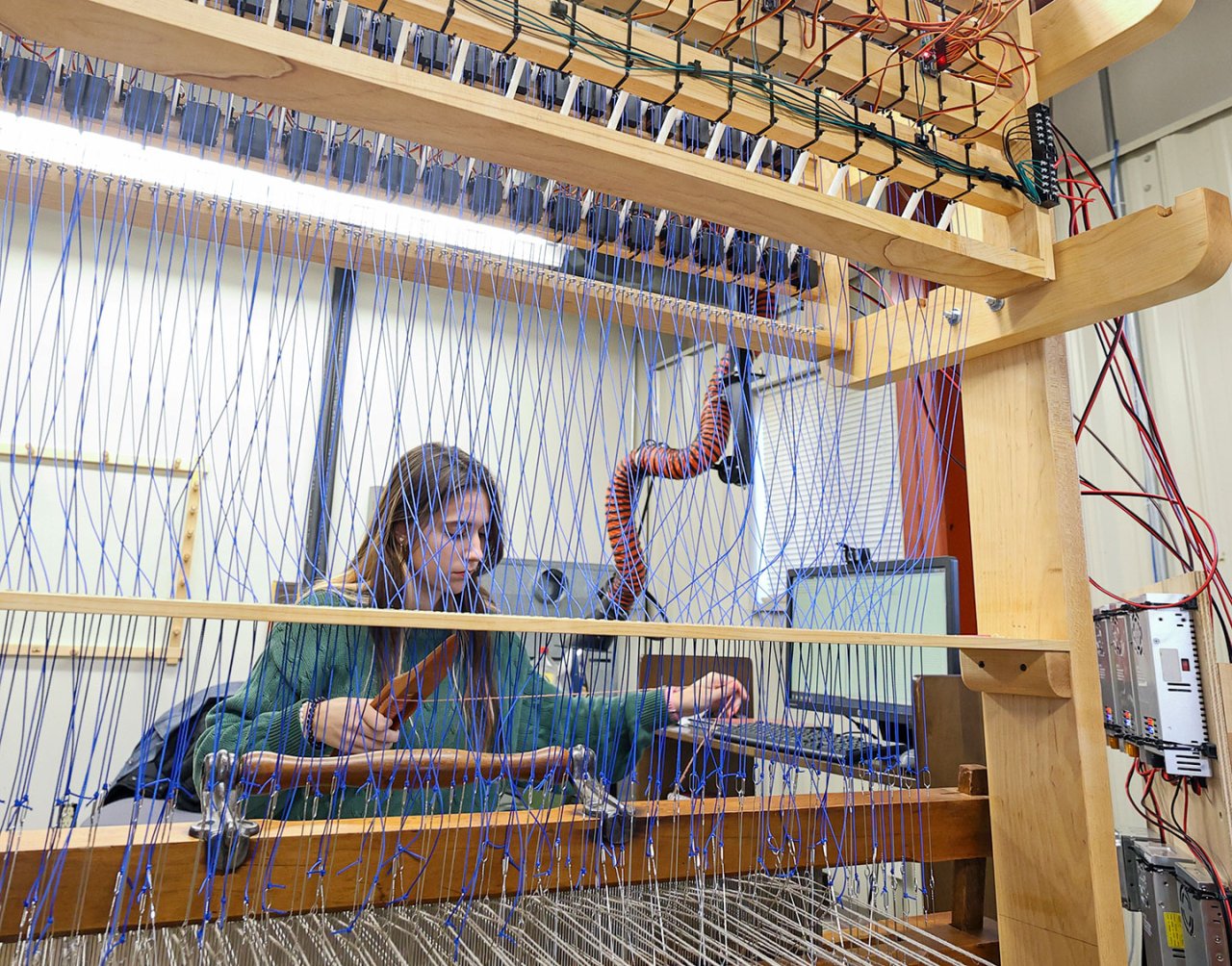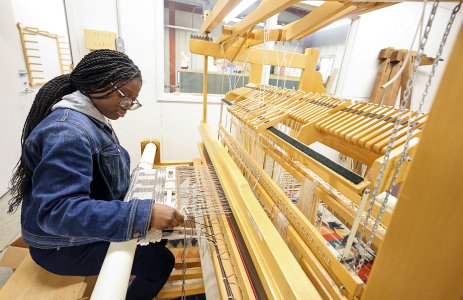Generative Art
Ohio Wesleyan Professors Weave Art and Science Together in Team-Taught Course

Two Ohio Wesleyan University professors have developed a unique way to weave learning into a class that combines their diverse areas of expertise – Mathematics & Computer Science and Fine Arts.
Professors Craig Jackson, Ph.D., and Jeff Nilan, MFA, have created a digitally controlled Jacquard loom. The customized, computerized device creates intricate fabrics by using up to 400 miniature “servo” motors to precisely control the warps and wefts of the weaving process. The loom allows the professors to expand their focus on textile processes in their team-taught Generative Art 200.4 course.
‘New and Exciting Area’

“We believe that using woven textiles as a medium for generative art is a new and exciting area for research, teaching, and artistic practice,” the professors say. “Very few artists are working at this intersection of generative design and textiles.”
When creating generative art, they explain, artists deliberately cede control over a significant aspect of their work to an external agent.
“Having access to a Jacquard loom greatly increases the control the weaver has over their design,” Jackson and Nilan state. “What we are interested in, however, is the ability a Jacquard loom gives an artist to relinquish control over their design. The artist still sits at the loom and weaves the textile, but the computer program dictates the design. So, we are exploring the use of generative design principles made possible by having a Jacquard loom that can be digitally controlled via a computer.”
In their class, OWU students work to create generative art across a range of 2-dimensional media, including textiles produced using the Jacquard loom. Housed in Haycock Hall, the loom also provides Fine Arts students with “a hands-on example of the use of digital microcontrollers in the production and installation of art,” the professors state, “an entire area of artistic practice (previously) unavailable to our students.”
A Successful Collaboration
Their collaboration already has resulted in Jackson and Nilan presenting at two professional conferences: In-person at Generative ART XXIV in Cagliari, Italy, and online at the 20th Annual STS Conference Graz, “Critical Issues in Science, Technology and Society Studies,” held in Graz, Austria. The OWU professors also have authored a peer-reviewed paper, “A Collaborative, Interdisciplinary Undergraduate Course on Generative Art,” published by the Graz University of Technology.
They earned an OWU Thomas E. Wenzlau Grant in 2022 to design and build the loom. The project, completed this fall, took longer than anticipated because of the time required to design and build a one-off device that incorporates hundreds of moving parts, said Jackson, who installed all the motors. They are a critical component of the loom, he explained, because they can be positioned at any rotational angle between 0 and 180 degrees via remote control, allowing creation of the intricate textiles.
The team-taught course furthers goals for both Fine Arts and Mathematics & Computer Science departments, Jackson and Nilan say, adding textile design opportunities for aspiring artists while enhancing the hands-on, applied offerings available to future mathematicians and computer scientists. The digital loom project already has led to the beginning of a small weaving studio in Haycock Hall with four looms and plans for dying yarn with natural dyes.
Exploring What’s Going to Happen

Elsa Hoam ’27 of Fredericktown, Ohio, is one of the students working with the Jacquard loom. Although she’s not enrolled in the generative art class, she learned about the project from Nilan when she toured campus as a prospective student. She asked about the project this fall, and Nilan invited her to help.
“I’d done some weaving by hand and on smaller looms, and just the idea of this new exploration with a large loom and hands-on experience with it really excited me,” said Hoam, a double major in Business Administration (Marketing concentration) and Studio Art.
“I think it’s kind of interesting because I don’t really have to think too hard about what’s happening,” she said. “It’s more I’m exploring what’s going to happen. It’s kind of like finding a new place. You just don’t know what’s going to come out of it, but it’s always exciting to see what’s going to happen.”
Tera Berko ’27 of Westerville, Ohio, also is working with the digitally controlled loom. “I’ve just always liked fabric, and I sew. So, I heard about the loom project and I was like, ‘close enough,’” said Berko, a double major in Pre-Medicine and Psychology. “It’s a huge learning experience and I’m thankful for what I learn through it.”
Learn more about these Ohio Wesleyan areas of study at owu.edu/FineArts and owu.edu/math.
